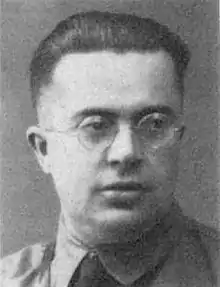Otto Hellmuth
Otto Hellmuth (July 22, 1896 – April 20, 1968) was a member of the Nazi Party and the Gauleiter in Lower Franconia (Unterfranken) from 1928 to 1945.
Otto Hellmuth | |
|---|---|
 Otto Hellmuth | |
| Gauleiter of Gau Mainfranken | |
| In office 1 October 1928 – 8 May 1945 | |
| Appointed by | Adolf Hitler |
| Deputy | Wilhelm Kühnreich |
| Preceded by | Position created |
| Succeeded by | Position abolished |
| Regierungsprasident of Lower Franconia | |
| In office 1 July 1934 – 8 May 1945 | |
| Personal details | |
| Born | 22 July 1896 Markt Einersheim |
| Died | 20 April 1968 (aged 71) Reutlingen |
| Political party | Nazi party |
| Alma mater | University of Würzburg. |
| Profession | Dentist |
Early life
Born at Markt Einersheim, during World War I he entered service as a Kriegsfreiwilliger in the Bavarian Army, assigned successively to Infanterie-Regiment Nr. 9, Reserve-Infanterie-Regiment Nr. 4 and Landwehr-Infanterie-Regiment Nr. 8. He was wounded in action four times. He returned to Germany in October 1918 after being severely gassed. He studied dentistry at the University of Freiburg and the University of Würzburg. He received his doctorate in 1922 and began practice as a dentist.
Nazi Party career
He joined the Nazi Party in 1922 before it was outlawed and re-joined in December 1925. He served as an Ortsgruppenleiter in Würzburg and joined the municipal council in Marktbreit. On 20 May 1928, Hellmuth was elected to the Bavarian Landtag.[1]
On 1 October 1928, Hellmuth was appointed Gauleiter of Lower Franconia (Gau Unterfranken). His home and office were in Würzburg the capital.[2] Three weeks before the first nationwide anti-Jewish boycott began in 1933, Hellmuth had already forced the closing of Jewish-owned stores and offices in Würzburg. In April 1929, he organized mass meetings to protest the death of a four-year-old child and alleged in an article in Der Stürmer that the child had been killed by Jews in a ritual murder. These accusations were dismissed after a police investigation.[3]
After the Nazi seizure of power, Hellmuth was elected to the Reichstag on 12 November 1933. On 1 July 1934, he became Regierungspräsident (Government President) of Unterfranken, thus uniting under his control the highest party and governmental offices in his jurisdiction. He had the Gau renamed Mainfranken on 30 July 1935. On 1 June 1938, the name of the government region was also changed to Mainfranken. After World War II, the region's original name was reinstated.[4] Unlike almost all other Gauleiters, Hellmuth did not belong to the SA or the SS. However, on 9 November 1939, he was made an Obergruppenführer in the National Socialist Motor Corps (Nationalsozialistisches Kraftfahrerkorps or NSKK). On 16 November 1942, he was appointed the Reich Defense Commissioner for his Gau.[5]
In 1936 he acquired the house of a Jewish pharmacist as his private residence by compelling the city to purchase it far below its market value. He lived here in great luxury with a large household staff.[6] When the Gaufrauenschaftsleiterin of Mainfranken paid Passau a formal visit, with a delegation of activists, Margarethe Schneider-Reichel presented them with a painting of Hellmuth.[7] Over most of his term, Hellmuth was not an impressive personality. Joseph Goebbels saw him as "a most retiring unassuming Gauleiter in whom one had not too much confidence." However, Hellmuth defended his Gau vigorously in the spring of 1945, as Goebbels noted in his diary on April 2.[8]
Post-war
He and his family fled Würzburg on 2 April 1945, two days before it fell to US forces. He fled to the Tyrol region of Austria where he was briefly detained by US troops in May. Escaping, he hid out as a farmworker in the Kassel area and then resumed the practice of dentistry under an assumed name. Discovered, he was arrested in May 1947 and accused of complicity in the murders of Allied aircraft pilots. He was tried at Dachau and sentenced to death. This sentence was later commuted to life imprisonment, then further reduced to 20 years. He was released from Landsberg prison in 1955, settled in Kassel and resumed his dental practice.[9]
Hellmuth killed himself on April 20, 1968 in Reutlingen.[10][11]
References
- Michael D. Miller & Andreas Schulz: Gauleiter: The Regional Leaders of the Nazi Party and Their Deputies, 1925-1945, Volume I (Herbert Albrecht - H. Wilhelm Hüttmann), R. James Bender Publishing, 2012, p. 454, ISBN 1-932970-21-5.
- Anna Rosmus Hitlers Nibelungen, Samples Grafenau 2015, pp. f
- Miller and Schulz, 2012, pp.454-455.
- https://www.historisches-lexikon-bayerns.de/Lexikon/Mainfranken
- Miller and Schulz, 2012, pp.454; 459.
- Miller and Schulz, 2012, p.458.
- Anna Rosmus Hitlers Nibelungen, Samples Grafenau 2015, p. 177
- Miller and Schulz, 2012, p. 461.
- Miller and Schulz, 2012, p.461.
- Anna Rosmus Hitlers Nibelungen, Samples Grafenau 2015, p. 177
- "Hellmuth, Otto". verwaltungshandbuch.bayerische-landesbibliothek-online.de (in German). Bayerische Landesbibliothek. Retrieved 20 April 2016.
External links
- Würzburg
- Gau Mainfranken at the Wayback Machine (archived October 29, 2009)